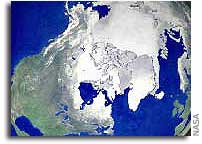NASA Arctic Sea Ice Study May Stir Up Climate Models

Contrary to historical observations, sea ice in the
high Arctic undergoes very small, back and forth movements
twice a day, even in the dead of winter. It was once
believed ice deformation at such a scale was almost non-
existent.
According to a recent NASA-funded study, the finding is
significant. Such movements may substantially increase the
production of new ice and should be factored into Arctic
climate models. The phenomenon of short-period Arctic sea
ice motion was investigated in detail in 1967 and has been
the subject of numerous research studies since.
A 1978 study found short-period ice motions disappeared
almost entirely during the winter once the Arctic Ocean
froze. A subsequent investigation in 2002, conducted using
measurements from ocean buoys spaced hundreds of kilometers
apart, found sea ice movement occurs during all seasons.
Since buoy observations are poor for understanding short
length-scale motion and deformation, researchers Ron Kwok
and Glenn Cunningham of NASA’s Jet Propulsion Laboratory,
Pasadena, Calif., and William Hibler III of the University
of Alaska, Fairbanks, set out to examine the phenomenon in
greater detail.
The researchers used high-resolution synthetic aperture
radar imagery from Canada’s RADARSAT Earth observation
satellite, which can image the region up to five times a
day. Their findings were published recently in Geophysical
Research Letters. The researchers studied an approximate 200
by 200 kilometer (124 by 124 mile) area in the Canada Basin
region of the high Arctic for about three weeks in May 2002
and in February 2003.
This region is representative of the behavior of the central
Arctic Ocean ice cover due to its location and thickness.
The time frame was selected because Arctic sea ice motion is
least expected during those times of year.
The study provided a more detailed picture of the phenomenon
reported in the 2002 buoy research. It found sea ice moved
back and forth and deformed slightly in a persistent 12-hour
oscillating pattern. Subtle motions triggered by the Earth’s
rotation rather than by tidal movement likely caused the
pattern. In the absence of external forces, any object will
move in a circular motion due to the Earth’s rotation. The
researchers attributed the winter behavior of the ice cover,
not observed in studies before 1970, to either a previous
lack of detailed data or perhaps an indication of recent
thinning of the Arctic ice cover.
“If Arctic pack ice is continually opening and closing
during the Arctic winter on a widespread basis, it could
significantly increase the rate of Arctic ice production and
therefore increase the total amount of ice in the Arctic,”
Kwok said. “A simple simulation of this ice production
process shows that it can account for an equivalent of 10
centimeters (4 inches) of ice thickness over six months of
winter. That’s approximately 20 percent of the base growth
of thick ice during the central Arctic winter.”
Kwok said current models of the dynamics of Arctic sea ice
typically don’t take into account processes occurring at
short, 12-hour time scales, and the impact of such processes
must be assessed. “As climate models continue to get better
and better, it becomes increasingly important to understand
the physics of small-scale processes so that we can
understand their large-scale consequences,” he said. “If
these Arctic sea ice processes are indeed important over the
entire Arctic basin, their contribution to the overall
amount of ice in the Arctic should be included in
simulations of the interactions that take place between the
Arctic’s ice, ocean and atmosphere to create the overall
Arctic climate.
“If such oscillations in Arctic sea ice increase as the sea
ice cover thins due to warmer atmospheric temperatures, then
this mechanism of ice production may actually serve to slow
down the overall depletion of ice in the Arctic Ocean,” he
added. Kwok said other parts of the Arctic Ocean would be
analyzed in future studies.
For information about the study on the Internet, visit:
http://www.earth.nasa.gov/flash_top.html
For information about NASA on the Internet, visit:









